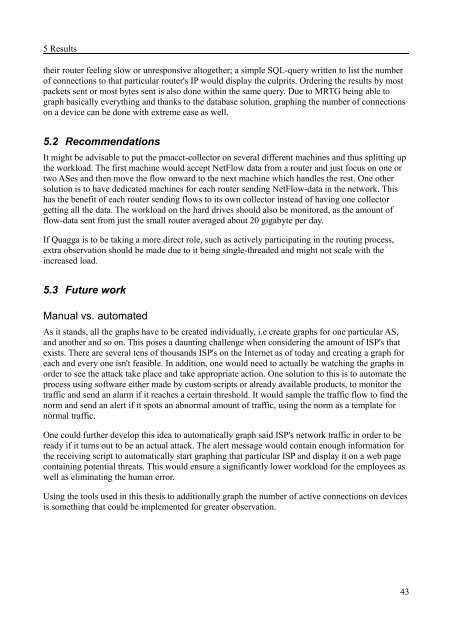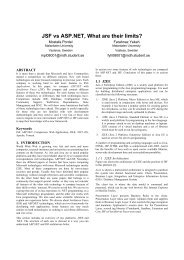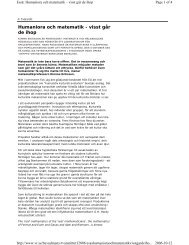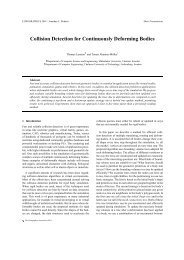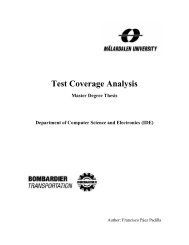Implementation of data collection tools using NetFlow for statistical ...
Implementation of data collection tools using NetFlow for statistical ...
Implementation of data collection tools using NetFlow for statistical ...
You also want an ePaper? Increase the reach of your titles
YUMPU automatically turns print PDFs into web optimized ePapers that Google loves.
5 Results<br />
their router feeling slow or unresponsive altogether; a simple SQL-query written to list the number<br />
<strong>of</strong> connections to that particular router's IP would display the culprits. Ordering the results by most<br />
packets sent or most bytes sent is also done within the same query. Due to MRTG being able to<br />
graph basically everything and thanks to the <strong>data</strong>base solution, graphing the number <strong>of</strong> connections<br />
on a device can be done with extreme ease as well.<br />
5.2 Recommendations<br />
It might be advisable to put the pmacct-collector on several different machines and thus splitting up<br />
the workload. The first machine would accept <strong>NetFlow</strong> <strong>data</strong> from a router and just focus on one or<br />
two ASes and then move the flow onward to the next machine which handles the rest. One other<br />
solution is to have dedicated machines <strong>for</strong> each router sending <strong>NetFlow</strong>-<strong>data</strong> in the network. This<br />
has the benefit <strong>of</strong> each router sending flows to its own collector instead <strong>of</strong> having one collector<br />
getting all the <strong>data</strong>. The workload on the hard drives should also be monitored, as the amount <strong>of</strong><br />
flow-<strong>data</strong> sent from just the small router averaged about 20 gigabyte per day.<br />
If Quagga is to be taking a more direct role, such as actively participating in the routing process,<br />
extra observation should be made due to it being single-threaded and might not scale with the<br />
increased load.<br />
5.3 Future work<br />
Manual vs. automated<br />
As it stands, all the graphs have to be created individually, i.e create graphs <strong>for</strong> one particular AS,<br />
and another and so on. This poses a daunting challenge when considering the amount <strong>of</strong> ISP's that<br />
exists. There are several tens <strong>of</strong> thousands ISP's on the Internet as <strong>of</strong> today and creating a graph <strong>for</strong><br />
each and every one isn't feasible. In addition, one would need to actually be watching the graphs in<br />
order to see the attack take place and take appropriate action. One solution to this is to automate the<br />
process <strong>using</strong> s<strong>of</strong>tware either made by custom scripts or already available products, to monitor the<br />
traffic and send an alarm if it reaches a certain threshold. It would sample the traffic flow to find the<br />
norm and send an alert if it spots an abnormal amount <strong>of</strong> traffic, <strong>using</strong> the norm as a template <strong>for</strong><br />
normal traffic.<br />
One could further develop this idea to automatically graph said ISP's network traffic in order to be<br />
ready if it turns out to be an actual attack. The alert message would contain enough in<strong>for</strong>mation <strong>for</strong><br />
the receiving script to automatically start graphing that particular ISP and display it on a web page<br />
containing potential threats. This would ensure a significantly lower workload <strong>for</strong> the employees as<br />
well as eliminating the human error.<br />
Using the <strong>tools</strong> used in this thesis to additionally graph the number <strong>of</strong> active connections on devices<br />
is something that could be implemented <strong>for</strong> greater observation.<br />
43


